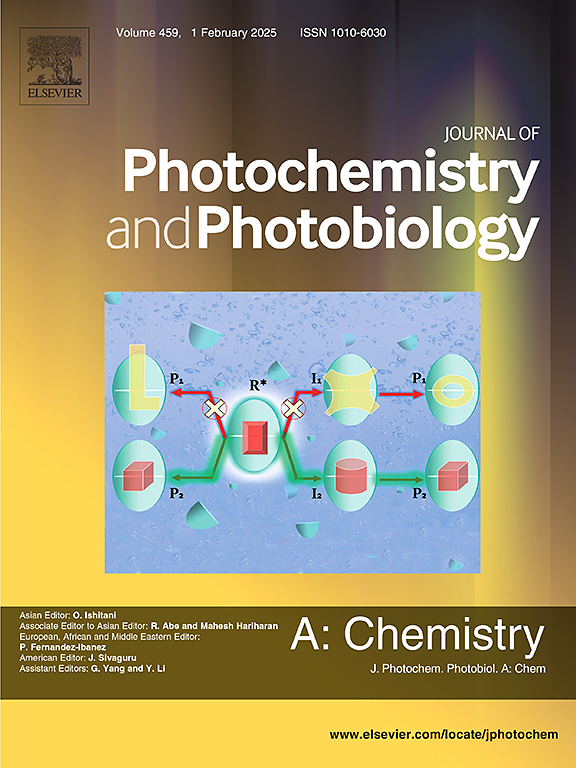Synthesis of red carbon quantum dots with solvatochromic properties as a selective luminescence probe of MnO4−
IF 4.1
3区 化学
Q2 CHEMISTRY, PHYSICAL
Journal of Photochemistry and Photobiology A-chemistry
Pub Date : 2025-01-21
DOI:10.1016/j.jphotochem.2025.116288
引用次数: 0
Abstract
Red efficient luminescent carbon quantum dots are still difficult to be synthesized. In this work, red carbon quantum dots (RCQDs) isopropanol solution with quantum yield of 43.9 % have been synthesized using isopropanol as carbon source and solvent, N1-phenylbenzene-1,2,4-triamine as carbon and nitrogen source. The solvothermal synthesis was catalyzed surprisingly by SnO2 nanoparticles, the optimal synthesis temperature was lowered to 130 °C, and the optimal synthesis time was reduced to 1 h. Moreover, the RCQDs nanoparticles showed excellent solvatochromic properties. The maximum emission wavelength for RCQDs in N, N-dimethylformamide dilute solution blue shifted to 504 nm, and the maximum emission wavelengths for RCQDs in acetone, isopropanol, dimethyl sulfoxide and water solutions were in the range of 592 nm ∼ 624 nm. The reason was investigated by the in-situ infrared absorption spectra. MnO4− ions could be selectively detected using RCQDs in PBS buffer solution (pH = 5.0), the linear range of MnO4− concentration was 0.1 μM ∼ 2.0 μM. This work provides a new synthesis method of efficient red carbon quantum dots, and it supplies a friendly candidate for detection of MnO4− ions in water.

求助全文
约1分钟内获得全文
求助全文
来源期刊
CiteScore
7.90
自引率
7.00%
发文量
580
审稿时长
48 days
期刊介绍:
JPPA publishes the results of fundamental studies on all aspects of chemical phenomena induced by interactions between light and molecules/matter of all kinds.
All systems capable of being described at the molecular or integrated multimolecular level are appropriate for the journal. This includes all molecular chemical species as well as biomolecular, supramolecular, polymer and other macromolecular systems, as well as solid state photochemistry. In addition, the journal publishes studies of semiconductor and other photoactive organic and inorganic materials, photocatalysis (organic, inorganic, supramolecular and superconductor).
The scope includes condensed and gas phase photochemistry, as well as synchrotron radiation chemistry. A broad range of processes and techniques in photochemistry are covered such as light induced energy, electron and proton transfer; nonlinear photochemical behavior; mechanistic investigation of photochemical reactions and identification of the products of photochemical reactions; quantum yield determinations and measurements of rate constants for primary and secondary photochemical processes; steady-state and time-resolved emission, ultrafast spectroscopic methods, single molecule spectroscopy, time resolved X-ray diffraction, luminescence microscopy, and scattering spectroscopy applied to photochemistry. Papers in emerging and applied areas such as luminescent sensors, electroluminescence, solar energy conversion, atmospheric photochemistry, environmental remediation, and related photocatalytic chemistry are also welcome.

 求助内容:
求助内容: 应助结果提醒方式:
应助结果提醒方式:


